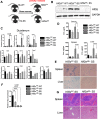Intestine-specific Disruption of Hypoxia-inducible Factor (HIF)-2α Improves Anemia in Sickle Cell Disease
- PMID: 26296885
- PMCID: PMC4583015
- DOI: 10.1074/jbc.C115.681643
Intestine-specific Disruption of Hypoxia-inducible Factor (HIF)-2α Improves Anemia in Sickle Cell Disease
Abstract
Sickle cell disease (SCD) is caused by genetic defects in the β-globin chain. SCD is a frequently inherited blood disorder, and sickle cell anemia is a common type of hemoglobinopathy. During anemia, the hypoxic response via the transcription factor hypoxia-inducible factor (HIF)-2α is highly activated in the intestine and is essential in iron absorption. Intestinal disruption of HIF-2α protects against tissue iron accumulation in iron overload anemias. However, the role of intestinal HIF-2α in regulating anemia in SCD is currently not known. Here we show that in mouse models of SCD, disruption of intestinal HIF-2α significantly decreased tissue iron accumulation. This was attributed to a decrease in intestinal iron absorptive genes, which were highly induced in a mouse model of SCD. Interestingly, disruption of intestinal HIF-2α led to a robust improvement in anemia with an increase in RBC, hemoglobin, and hematocrit. This was attributed to improvement in RBC survival, hemolysis, and insufficient erythropoiesis, which is evident from a significant decrease in serum bilirubin, reticulocyte counts, and serum erythropoietin following intestinal HIF-2α disruption. These data suggest that targeting intestinal HIF-2α has a significant therapeutic potential in SCD pathophysiology.
Keywords: HIF-2α; anemia; hypoxia; hypoxia-inducible factor (HIF); intestinal epithelium; iron; iron homeostasis; iron metabolism; sickle cell disease.
© 2015 by The American Society for Biochemistry and Molecular Biology, Inc.
Figures


References
Publication types
MeSH terms
Substances
Grants and funding
LinkOut - more resources
Full Text Sources
Medical

